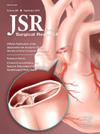Efficacy of a Novel Hemostatic Material “Sodium Calcium Alginate’’ in a Porcine Acute Phase Model
IF 1.7
3区 医学
Q2 SURGERY
引用次数: 0
Abstract
Introduction
Although biologically derived hemostatic materials have satisfactory performance, they involve the risk of infection. We have developed a novel hemostatic material, sodium calcium alginate (Na/Ca alginate), based on the nonbiological material sodium alginate. This study aimed to evaluate the hemostatic efficacy of our Na/Ca alginate compared with conventional nonbiological and biological agents.
Methods
We manufactured the Na/Ca alginate with optimized hemostatic properties according to our previous studies. We adopted microporous starch and oxidized cellulose as nonbiological existing hemostatic agents and fibrin glue as an existing biological hemostatic agent. Standardized punch-out wounds were created in porcine livers using a biopsy punch. Each hemostatic material was then applied, and hemostatic efficacy was evaluated at 2 and 5 min after application.
Results
The degree of bleeding was comparable at each group. Na/Ca alginate showed significantly higher hemostatic efficacy than microporous starch and oxidized cellulose at 2 min after application (Na/Ca alginate 90% versus microporous starch 0% versus oxidized cellulose 50%, P < 0.01). The finding persisted at 5 min (86.7% versus 0% versus 43.3%, P < 0.01). Na/Ca alginate also showed significantly higher hemostatic efficacy compared to fibrin glue at 2 min (Na/Ca alginate 94.1% versus fibrin glue 50.0%, P < 0.01). At the 5-min evaluation, there was no statistically significant difference between Na/Ca alginate and fibrin glue (94.1% versus 85.3%, P = 0.427).
Conclusions
Our novel Na/Ca alginate demonstrated superior hemostatic efficacy compared to existing nonbiological hemostatic agents and achieved more rapid hemostasis than the existing biological hemostatic agent.
新型止血材料“海藻酸钙钠”在猪急性期模型中的疗效
虽然生物来源的止血材料具有令人满意的性能,但它们存在感染的风险。我们在非生物材料海藻酸钠的基础上开发了一种新型止血材料——海藻酸钙钠(Na/Ca alginate)。本研究旨在评价我们的海藻酸钠/钙与传统的非生物和生物制剂的止血效果。方法在前人研究的基础上制备具有最佳止血性能的海藻酸钠/海藻酸钙。我们采用微孔淀粉和氧化纤维素作为非生物现有止血剂,采用纤维蛋白胶作为现有生物止血剂。标准化的穿孔伤口是用活组织检查穿孔在猪肝上形成的。然后应用每种止血材料,并在应用后2和5分钟评估止血效果。结果两组患者出血程度具有可比性。应用后2分钟,钠/海藻酸钙的止血效果显著高于微孔淀粉和氧化纤维素(钠/海藻酸钙90%,微孔淀粉0%,氧化纤维素50%,P <;0.01)。这一发现持续了5分钟(86.7% vs . 0% vs . 43.3%, P <;0.01)。与纤维蛋白胶相比,钠/海藻酸钙在2分钟的止血效果也显著提高(钠/海藻酸钙94.1%比纤维蛋白胶50.0%,P <;0.01)。在5分钟评估时,海藻酸钠/钙与纤维蛋白胶的差异无统计学意义(94.1%比85.3%,P = 0.427)。结论新型海藻酸钠/海藻酸钙止血效果优于现有的非生物止血剂,止血效果优于现有的生物止血剂。
本文章由计算机程序翻译,如有差异,请以英文原文为准。
求助全文
约1分钟内获得全文
求助全文
来源期刊
CiteScore
3.90
自引率
4.50%
发文量
627
审稿时长
138 days
期刊介绍:
The Journal of Surgical Research: Clinical and Laboratory Investigation publishes original articles concerned with clinical and laboratory investigations relevant to surgical practice and teaching. The journal emphasizes reports of clinical investigations or fundamental research bearing directly on surgical management that will be of general interest to a broad range of surgeons and surgical researchers. The articles presented need not have been the products of surgeons or of surgical laboratories.
The Journal of Surgical Research also features review articles and special articles relating to educational, research, or social issues of interest to the academic surgical community.

 求助内容:
求助内容: 应助结果提醒方式:
应助结果提醒方式:


